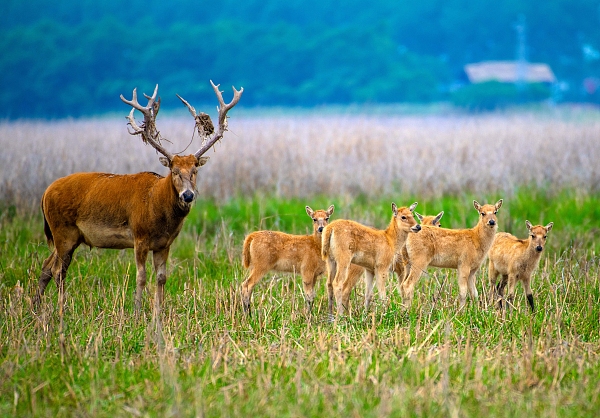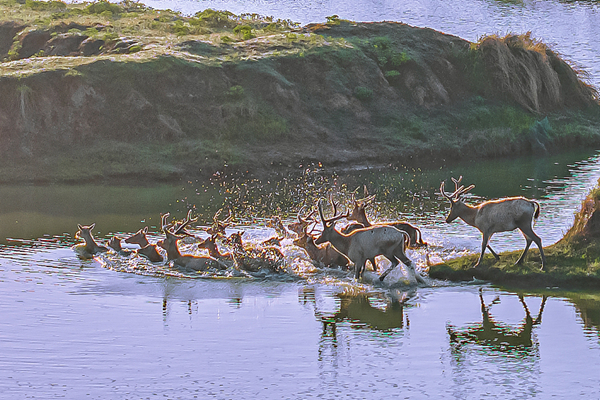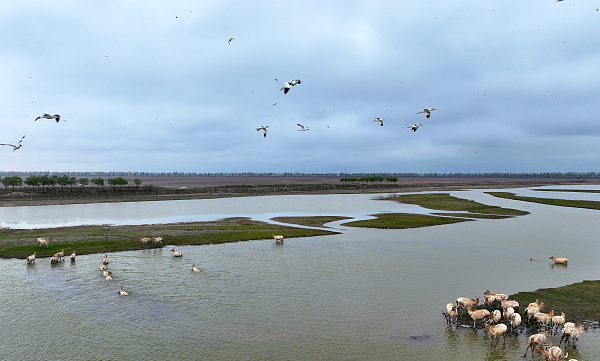Elders lead transformation of ancient estuary into beacon of biodiversity

(CFP Photo)
Ma Lianyi spent the first half of his life working at the source region of the Yangtze River, longing for his hometown of Yancheng City in Jiangsu Province. Then for his latter half, he has devoted himself to the development of Yeludang, literally “a marsh for wild deer,” at the 10,000-year-old Yangtze River estuary in the city’s Dafeng District.
From headwater to the sea

The 72-year-old used to work at Yanshiping Town, located at the northern pass of the Tanggula Mountains and near the border of the uninhabited area of Hoh Xil. In his memory, it was just hundreds of meters to walk from the Qinghai-Xizang Highway to reach Tuotuo River, which is a source of the Yangtze River.
After working there for over 20 years, Ma returned to Yancheng, which borders the Yellow Sea. Upon reading a report by Wang Ying, a member of the Chinese Academy of Sciences, Ma realized that the city’s Jianggang area was the northern mouth of the Yangtze River entering the sea 10,000 years ago. This revelation excited him because it seemed that his entire life was closely connected with the river, from its source to its end. Later, he visited the site described in the report, a tidal flat along Chuandong Port.
He hoped more people would come to know this place and was determined to transform the tidal flat into a national geographic landmark. At that time, the Chuandong River was undergoing massive construction for a major water conservancy project, so the area was used as a land fill for sands and trash. Ma led a team to repair roads, clean up channels, plant local tree species and grasses, and create shallow bays to form green habitats. Despite the hard labor, opposition from villagers, and doubts from his family, Ma remained firmly committed to creating a vibrant natural ecosystem.

Later, Ma sought assistance from Professor Li Baohua from the Nanjing Institute of Geology and Palaeontology, Chinese Academy of Sciences. A team led by Li conducted the rock core analysis and discovered hundreds of microfossils, such as foraminifera, ostracods, pollen and spores. This research helped verify the location as the geographical landmark for the ancient Yangtze River's northern estuary. Experts also believe that the estuary was home to nearly 10,000 species 10,000 years ago, although few are visible now.
Over the course of 2-3 years, Ma and his supporters travelled hundreds of kilometers along the coastal area from south to north, discovering ships left over 100 years ago, and even several anchors from the late Qing Dynasty (1644-1911) stranded on the beach. Step by step, they established a research institute on the vast beach to preserve relics from nearly 1,000 species in the south wetlands of the Yellow Sea.
When Ma first returned to Yancheng, it coincided with the release of 39 milu deer into the Dafeng reserve. Over the years, this initiative has become a global role model for reintroducing species to the wild, a success that also prompted the site’s new name Yeludang.
A stargazer’s heaven

Furthermore, Yeludang is the third dark sky reserve established by the China Biodiversity Conservation and Green Development Foundation (CBCGDF), following two conversation areas in Ngari and Naqu, both in China’s Xizang autonomous region. Ma was a central figure in the establishment of the first dark sky reserve along the coastal region in China, which boasts an average of 238 days per year suitable for observing the starry sky.
Initially, he had low expectations for the project because the coastal area is humid and visibility is often low. However, studies revealed that this area of 40 square kilometers is free from light pollution, and the atmospheric visibility fully meets the standards of a dark sky area. This has been hailed as a miracle given that China’s eastern coastal areas are generally densely populated and have a humid climate.
Afterwards, the Earth Rotation Observation Station was established at Yeludang, as this venue is far from urban light pollution and enhances observational accuracy. Without these efforts, Ma believed this place would have remained a deserted beach. He holds the belief that every piece of land has its own story and a scientific approach is the best solution.
The shared mission of six elders

Ma is certainly not alone in promoting Yeludang’s development. His team once included five other elders from Guangdong, Fujian, Shanghai and Tianjin - Tao Heming, Ni Guangbao, Zhou Huiliang, Li Qinghu and Cheng Tongfu. Describing the place as “a grand and vivid watercolor painting worth of conservation, restoration and cherishing,”one of them even decided to spend his final three years in this region.
With varied backgrounds, the six elders shared the same dream. Notably, Tao Heming, a former teacher at Xiamen University, moved to Yeludang at the age of 72 and stayed for four years. As his health declined in 2018, just before his passing, he arranged for the delivery of over 4,000 wooden stakes to be placed in the shallow bay for large birds to perch on. Ma recalls Tao’s wish: “When flocks of birds return and perch on the stakes, it means I have also returned, and I have never left this place.”
Ma’s endeavors have inspired many young people to support the cause. Since 2020, Ma and his team have run a Nature Classroom in Yeludang, hosting over 400 sessions in four years.
Ma's daughter serves as a volunteer teacher of the Nature Classroom, and his grandchildren are also volunteers, delving into the secrets of wild grass.
With the revitalization of the local ecosystem, Ma collaborates with key laboratories on field surveys, identifying and protecting 312 species of wild plants over ten years. Meanwhile, the original 39 deer introduced to Dafeng have thrived and multiplied. As of last year, the reserve boasted a population of 7,840 deer, including 3,356 wild deer, with some using Yeludang as their breeding place.